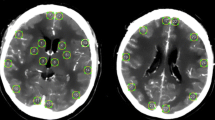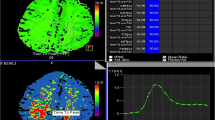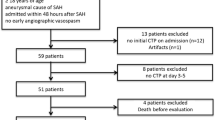Abstract
Objective
To evaluate the utility of computed tomography perfusion (CTP) both at admission and during delayed cerebral ischemia time-window (DCITW) in the detection of delayed cerebral ischemia (DCI) and the change in CTP parameters from admission to DCITW following aneurysmal subarachnoid hemorrhage.
Methods
Eighty patients underwent CTP at admission and during DCITW. The mean and extreme values of all CTP parameters at admission and during DCITW were compared between the DCI group and non-DCI group, and comparisons were also made between admission and DCITW within each group. The qualitative color-coded perfusion maps were recorded. Finally, the relationship between CTP parameters and DCI was assessed by receiver operating characteristic (ROC) analyses.
Results
With the exception of cerebral blood volume (P=0.295, admission; P=0.682, DCITW), there were significant differences in the mean quantitative CTP parameters between DCI and non-DCI patients both at admission and during DCITW. In the DCI group, the extreme parameters were significantly different between admission and DCITW. The DCI group also showed a deteriorative trend in the qualitative color-coded perfusion maps. For the detection of DCI, mean transit time to the center of the impulse response function (Tmax) at admission and mean time to start (TTS) during DCITW had the largest area under curve (AUC), 0.698 and 0.789, respectively.
Conclusion
Whole-brain CTP can predict the occurrence of DCI at admission and diagnose DCI during DCITW. The extreme quantitative parameters and qualitative color-coded perfusion maps can better reflect the perfusion changes of patients with DCI from admission to DCITW.
Similar content being viewed by others
References
Mackey J, Khoury JC, Alwell K, et al. Stable incidence but declining case-fatality rates of subarachnoid hemorrhage in a population. Neurology, 2016,87(21):2192–2197
Lovelock CE, Rinkel GJ, Rothwell PM. Time trends in outcome of subarachnoid hemorrhage: Population-based study and systematic review. Neurology, 2010,74(19):1494–1501
Bosche B, Graf R, Ernestus RI, et al. Recurrent spreading depolarizations after subarachnoid hemorrhage decreases oxygen availability in human cerebral cortex. Ann Neurol, 2010,67(5):607–17
Vergouwen MD, Vermeulen M, Coert BA, et al. Microthrombosis after aneurysmal subarachnoid hemorrhage: an additional explanation for delayed cerebral ischemia. J Cereb Blood Flow Metab, 2008,28(11):1761–1770
Jaeger M, Schuhmann MU, Soehle M, et al. Continuous monitoring of cerebrovascular autoregulation after subarachnoid hemorrhage by brain tissue oxygen pressure reactivity and its relation to delayed cerebral infarction. Stroke, 2007,38(3):981–986
Geraghty JR, Testai FD. Delayed Cerebral Ischemia after Subarachnoid Hemorrhage: Beyond Vasospasm and Towards a Multifactorial Pathophysiology. Curr Atheroscler Rep, 2017,19(12):50
Roos YB, de Haan RJ, Beenen LF, et al. Complications and outcome in patients with aneurysmal subarachnoid haemorrhage: a prospective hospital based cohort study in the Netherlands. J Neurol Neurosurg Psychiatry, 2000,68(3):337–341
Fujii M, Yan J, Rolland WB, et al. Early brain injury, an evolving frontier in subarachnoid hemorrhage research. Transl Stroke Res, 2013,4(4):432–446
Mir DI, Gupta A, Dunning A, et al. CT perfusion for detection of delayed cerebral ischemia in aneurysmal subarachnoid hemorrhage: a systematic review and meta-analysis. AJNR Am J Neuroradiol, 2014,35(5):866–871
Wilson CD, Shankar JJ. Diagnosing Vasospasm After Subarachnoid Hemorrhage: CTA and CTP. Can J Neurol Sci, 2014,41(3):314–319
Rodriguez-Régent C, Hafsa M, Turc G, et al. Early quantitative CT perfusion parameters variation for prediction of delayed cerebral ischemia following aneurysmal subarachnoid hemorrhage. Eur Radiol, 2016,26(9):2956–2963
Sun H, Li W, Ma J, et al. CT perfusion diagnoses delayed cerebral ischemia in the early stage of the time-window after aneurysmal subarachnoid hemorrhage. J Neuroradiol, 2017,44(5):313–318
Dankbaar JW, de Rooij NK, Rijsdijk M, et al. Diagnostic threshold values of cerebral perfusion measured with computed tomography for delayed cerebral ischemia after aneurysmal subarachnoid hemorrhage. Stroke, 2010,41(9):1927–1932
Dong L, Zhou Y, Wang M, et al. Whole-brain CT perfusion on admission predicts delayed cerebral ischemia following aneurysmal subarachnoid hemorrhage. Eur J Radiol, 2019,116:165–173
Schubert GA, Seiz M, Hegewald AA, et al. Acute hypoperfusion immediately after subarachnoid hemorrhage: a xenon contrast-enhanced CT study. J Neurotrauma, 2009, 26(12): 2225–31
Gölitz P, Hoelter P, Rösch J, et al. Ultra-early Detection of Microcirculatory Injury as Predictor of Developing Delayed Cerebral Ischemia After Aneurysmal Subarachnoid Hemorrhage. Clin Neuroradiol, 2018,28(4):501–507
Yu Z, Zheng J, Ma L, et al. Predictive Value of Cerebral Autoregulation Impairment for Delayed Cerebral Ischemia in Aneurysmal Subarachnoid Hemorrhage: A Meta-Analysis. World Neurosurg, 2019,126:e853–e859
Steiner T, Juvela S, Unterberg A, et al. European Stroke Organization guidelines for the management of intracranial aneurysms and subarachnoid haemorrhage. Cerebrovasc Dis, 2013,35(2):93–112
Vergouwen MD, Vermeulen M, van Gijn J, et al. Definition of delayed cerebral ischemia after aneurysmal subarachnoid hemorrhage as an outcome event in clinical trials and observational studies: proposal of a multidisciplinary research group. Stroke, 2010,41(10):2391–2395
Tallarico RT, Pizzi MA, Freeman WD. Investigational drugs for vasospasm after subarachnoid hemorrhage. Expert Opin Investig Drugs, 2018,27(4):313–324
Ko SB, Choi HA, Carpenter AM, et al. Quantitative analysis of hemorrhage volume for predicting delayed cerebral ischemia after subarachnoid hemorrhage. Stroke, 2011,42(3):669–674
Olsen MH, Orre M, Leisner ACW, et al. Delayed cerebral ischaemia in patients with aneurysmal subarachnoid haemorrhage: Functional outcome and long-term mortality. Acta Anaesthesiol Scand, 2019,63(9):1191–1199
Fragata I, Alves M, Papoila AL, et al. Computed tomography perfusion as a predictor of delayed cerebral ischemia and functional outcome in spontaneous subarachnoid hemorrhage: A single center experience. Neuroradiol J, 2019,32(3):179–188
Davis S, Donnan GA. Time is Penumbra: imaging, selection and outcome. The Johann jacob wepfer award 2014. Cerebrovasc Dis, 2014,38(1):59–72
Budohoski KP, Czosnyka M, Smielewski P, et al. Monitoring Cerebral Autoregulation After Subarachnoid Hemorrhage. Acta Neurochir Suppl, 2016,122:199–203
Zijlstra IA, Gathier CS, Boers AM, et al. Association of Automatically Quantified Total Blood Volume after Aneurysmal Subarachnoid Hemorrhage with Delayed Cerebral Ischemia. AJNR Am J Neuroradiol, 2016,37(9):1588–1593
Eagles ME, Tso MK, Macdonald RL. Cognitive Impairment, Functional Outcome, and Delayed Cerebral Ischemia After Aneurysmal Subarachnoid Hemorrhage. World Neurosurg, 2019,10:S1878–8750(19)30020-8
Sehba FA, Bederson JB. Mechanisms of acute brain injury after subarachnoid hemorrhage. Neurol Res, 2006,28(4):381–398
Author information
Authors and Affiliations
Corresponding author
Additional information
Conflict of Interest Statement
The authors declare that there is no conflict of interest with any financial organization or corporation or individual that can inappropriately influence this work.
The study was supported by the National Natural Science Foundation of China, Research on Brain Magnetic Resonance Image Segmentation Based on Particle Computation (No. 61672386).
Supplementary data
Rights and permissions
About this article
Cite this article
You, F., Tang, Wj., Zhang, C. et al. Whole-brain CT Perfusion at Admission and During Delayed Time-window Detects the Delayed Cerebral Ischemia in Patients with Aneurysmal Subarachnoid Hemorrhage. CURR MED SCI 43, 409–416 (2023). https://doi.org/10.1007/s11596-023-2703-z
Received:
Accepted:
Published:
Issue Date:
DOI: https://doi.org/10.1007/s11596-023-2703-z




